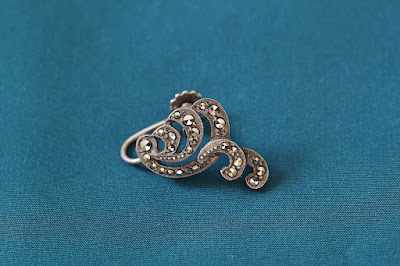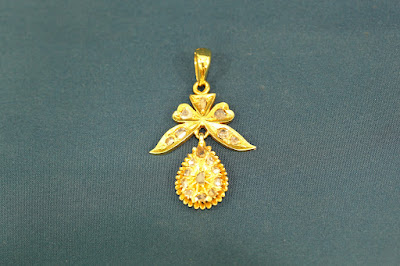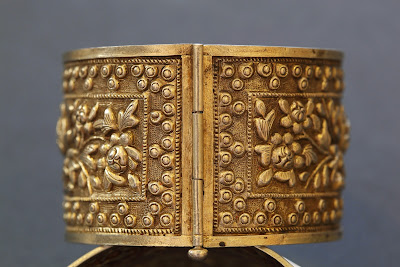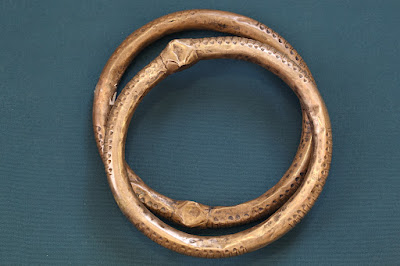Here are some of my collection of old Nyonya gold, intan, silver and gilded jewelleries.
Just like the Peranakan culture which is a hybrid of Chinese and Malay cultures, Peranakan jewellery reflects the two cultures' sense of aesthetics. The delicate and ornate curves of the floral motif reflect Malay wood carvery, for instance, and the use of dragonflies, phoenix (as seen in the picture below - gold necklace with intan), goldfish (as seen in the picture below - gold bracelet with intan), and peony flowers stem from auspicious meanings the Chinese attach to them.
 Picture 1
Picture 1
Simple silver pendant with Chinese characters "chu ru ping an", meaning may your coming and going be in peace. Size : 2cm x 3cm
Also check out the "Indian Anklets" and the "Wedding Necklaces".
Just like the Peranakan culture which is a hybrid of Chinese and Malay cultures, Peranakan jewellery reflects the two cultures' sense of aesthetics. The delicate and ornate curves of the floral motif reflect Malay wood carvery, for instance, and the use of dragonflies, phoenix (as seen in the picture below - gold necklace with intan), goldfish (as seen in the picture below - gold bracelet with intan), and peony flowers stem from auspicious meanings the Chinese attach to them.
 Picture 1
Picture 1Simple silver pendant with Chinese characters "chu ru ping an", meaning may your coming and going be in peace. Size : 2cm x 3cm
Also check out the "Indian Anklets" and the "Wedding Necklaces".

















































































Nicely curated collection! How old are the star shaped gold ear studs with intan?
ReplyDeleteThank you so much. :) It is indeed a very fine quality antique star-shaped gold ear studs, in one of the best conditions I have come across. Dating to the late 19th century, these earrings of Straits Settlements were made featured exceptionally clear natural old rose-cut diamonds, set in 18-karat rose-hued gold, with eight-pointed star that was well-loved, and furnished with original screw-type earring backs. I love it...
DeleteHi, i have seen a number of gold pendants with intan. Can you tell me the grade of gold that was used ? Is it mainly 18-carat? Thank you, I have enjoyed viewing your collection. Also, would you be able to give me an estimate value of pieces I have if I send you pictures of them?
ReplyDeleteHi Janie. Thank you so much for the compliments. To be honest with you, the grade of gold been used especially for the Peranakan and the Malay people for the past mostly were 9-14 carat. This is due to the intricate works of the pieces (by the goldsmiths) needed a "hard-base" material to create multiple shapes for a piece of jewellery. A pure gold or higher grade gold is too soft for these purposes (machine-cut designs were not existed during that era). Most of the people also call it 'suasa' gold / 'emas suasa'. In present days, people buying 'emas lama' / old gold jewelleries is not because of the gold contain in the jewellery itself, it is more on the arts and the craftsmanships of the pieces which is getting difficult to find these days. No doubt, there are higher grade gold or pure 999 (24 carat) gold been used too for jewelleries during that time, but the designs are not as "heavy" as the lower grade gold jewelleries. And of course, I'm more than happy to help if you have clear and nice pictures to share with me... :)
DeleteGood day, I've just started to collect old peranakan jewellery. Do you mind to share some pointers or advice on how to determine the authenticity of peranakan jewellery?
ReplyDeleteThanks for sharing us.
ReplyDeleteTitanium Pendants
Hi.my name is amizah i like your collection and i would like to know more about your bracelets collections. I'm doing research about malaysia traditional and antique bracelets.i hope you can help and give me some information and photo of the bracelets.hofe to hear form you.thank you
ReplyDeleteBuongiorno sono bellissimi , ma sono in vendita? Oltre che essere delizia per gli occhi?
ReplyDeleteHello there! I'm thrilled to have stumbled upon your blog. I noticed a necklace in one of your pictures that looks identical to one I have. It holds special meaning for me as it was a wedding gift from my mom. In my city, Kuching, Sarawak, this necklace is like an old antique piece that's hard to find. It's considered rare and carries a lot of sentimental value for me. It was famous in the 50's and 60's, more or less, and it is called "Lecha" in our language. Most Malay families do have at least a piece of this similar, whether a ring, necklace, or earring too. I've heard the price can go up to 20k as we speak. As they say, "hanya jauhari yang mengenal manikam" - only the jeweler knows the true worth. Needless to say, the 4th generation continues to gather/buying more of this kind of piece as we fell in love with the remarkable workmanship of this jewelry. Feel free to email me at nrbsrh@yahoo.com if you wanna know more as I love sharing my Sarawak Malay heritage with the world.
ReplyDelete